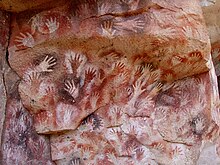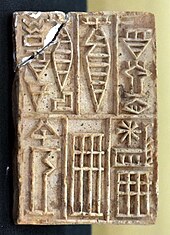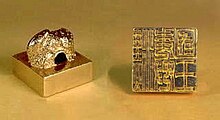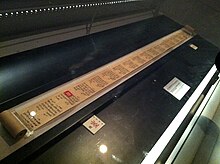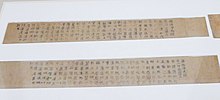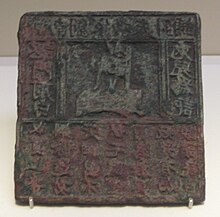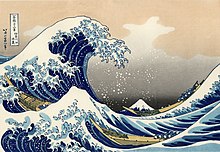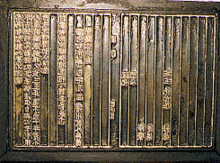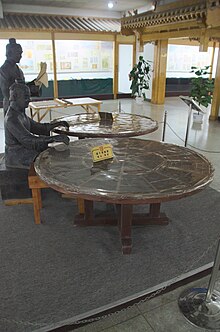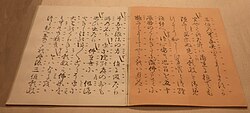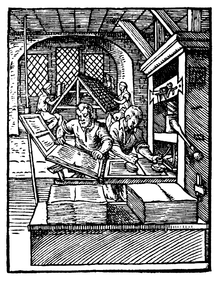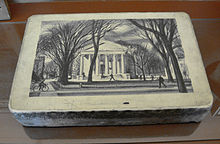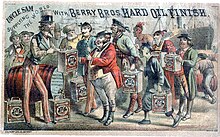History of printing
Movable type was invented by Chinese artisan Bi Sheng in the 11th century during the Song dynasty, but it received limited use compared to woodblock printing.
The Suishu jingjizhi, the blibography of the official history of the Sui dynasty, includes several ink-squeeze rubbings, believed to have led to the early duplication of texts that inspired printing.
According to Mahayana beliefs, religious texts hold intrinsic value for carrying the Buddha's word, and act as talismanic objects containing sacred power capable of warding off evil spirits.
The earliest extant example of this type of printed matter is a fragment of a dhāraṇī (Buddhist spell) miniature scroll written in Sanskrit unearthed in a tomb in Xi'an.
It is called the Great spell of unsullied pure light (Wugou jingguang da tuoluoni jing 無垢淨光大陀羅尼經) and was printed using woodblock during the Tang dynasty, c. 650–670 CE.
[19] This coincides with the reign of Wu Zetian, during which the Longer Sukhāvatīvyūha Sūtra, which advocates the practice of printing apotropaic and merit-making texts and images, was translated by Chinese monks.
The Great Dharani Sutra (Korean: 무구정광대다라니경, Hanja: 無垢淨光大陀羅尼經, romanized: Muggujeonggwang Daedharanigyeong) was discovered at Bulguksa, South Korea in 1966 and dated between 704 and 751 in the Later Silla era.
This copy of the Diamond Sutra is 14 feet (4.3 metres) long and contains a colophon at the inner end, which reads: Reverently [caused to be] made for universal free distribution by Wang Jie on behalf of his two parents on the 13th of the 4th moon of the 9th year of Xiantong [i.e. 11 May, AD 868 ].
Ukiyo-e is based on kabuki actors, sumo wrestlers, beautiful women, landscapes of sightseeing spots, historical tales, and so on, and Hokusai and Hiroshige are the most famous artists.
[38]In 1076, the 39 year old Su Shi remarked upon the unforeseen effect an abundance of books had on examination candidates: I can recall meeting older scholars, long ago, who said that when they were young they had a hard time getting their hands on a copy of Shiji or Han shu.
[41] Only relatively small volumes (juan 卷) were bound up, and several of these would be enclosed in a cover called a tao, with wooden boards at front and back, and loops and pegs to close up the book when not in use.
[60] Tsien suggests that woodblock printing may have spread from China to Europe due to communications during the Mongol Empire era and based on similarities between blockprints in both areas.
Paolo Giovio (1483 – 1552), an Italian historian who had come into possession of several Chinese books and maps through João de Barros (1496 – 1570), claimed that printing was invented in China and spread to Europe through Russia.
Juan González de Mendoza (1545 – 1618) made similar claims about printing coming from China through Russia but also added another route through Arabia by sea and that it influenced Johannes Gutenberg.
The next mention of movable type occurred in 1193 when a Southern Song chief counselor, Zhou Bida (周必大), attributed the movable-type method of printing to Shen Kuo.
The ceramic movable type was also mentioned by Kublai Khan's councilor Yao Shu, who convinced his pupil Yang Gu to print language primers using this method.
Another sample of Song dynasty money of the same period in the collection of Shanghai Museum has two empty square holes above Ziliao as well as Zihou, due to the loss of two copper movable types.
[28][81] Tokugawa Ieyasu established a printing school at Enko-ji in Kyoto and started publishing books using domestic wooden movable type printing-press instead of metal from 1599.
[28] The great pioneers in applying movable type printing press to the creation of artistic books, and in preceding mass production for general consumption, were Honami Kōetsu and Suminokura Soan.
At their studio in Saga, Kyoto, the pair created a number of woodblock versions of the Japanese classics, both text and images, essentially converting emaki (handscrolls) to printed books, and reproducing them for wider consumption.
[82] For aesthetic reasons, the typeface of the Saga-bon, like that of traditional handwritten books, adopted the renmen-tai (連綿体 [ja]), in which several characters are written in succession with smooth brush strokes.
T. H. Barrett points out that only Europeans who had never seen Chinese woodblock printing in action tended to dismiss it, perhaps due to the almost instantaneous arrival of both xylography and movable type in Europe.
While Wilkinson does not deny "China's dominance in book production from the fourth to the fifteenth century," he also insists that arguments for the Chinese advantage "should not be extended either forwards or backwards in time.
The high quality and relatively low price of the Gutenberg Bible (1455) established the superiority of movable type, and printing presses rapidly spread across Europe, leading up to the Renaissance, and later all around the world.
These printers owned shops, selected and edited manuscripts, determined the sizes of print runs, sold the works they produced, raised capital and organized distribution.
Rotary drum printing was invented by Josiah Warren in 1832,[113] whose design was later imitated by Richard March Hoe in 1843, patented in 1847, and then significantly improved by William Bullock in 1863.
In offset lithography, which depends on photographic processes, flexible aluminum, polyester, mylar or paper printing plates are used in place of stone tablets.
Screenprinting has its origins in simple stencilling, most notably of the Japanese form (katazome) user who cut banana leaves and inserted ink through the design holes on textiles, mostly for clothing.
Later some notable Chinese artists designed woodcuts for books, the individual print develop in China in the form of New Year picture as an art-form in the way it did in Europe and Japan.
The name xerography came from the Greek radicals xeros (dry) and graphos (writing), because there are no liquid chemicals involved in the process, unlike earlier reproduction techniques like cyanotype.
